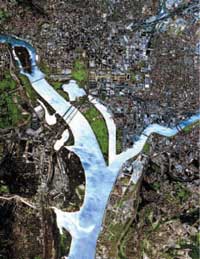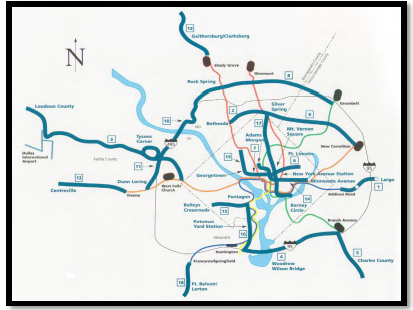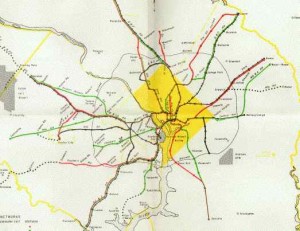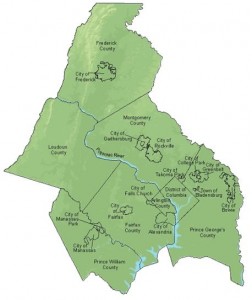Will the regional transit system be up to the challenge of meeting the Transportation Planning Board (TPB) Vision’s objectives and the Greater Washington 2050 Coalition Region Forward’s targets, especially for a higher transit mode share in 2040?

Image from mwcog.org
In early 2010, the Metropolitan Washington Council of Governments endorsed Region Forward. It includes goals, objectives and targets for the metropolitan area in 2050, relating to accessibility, sustainability, prosperity and livability. Transportation is one of nine categories among its goals, and the transportation targets draw heavily from the TPB Vision that was adopted in 1998. The Regional Transit System Plan (RTSP) is intended to help develop strategies to achieve Region Forward’s goals, objectives and targets. Several of these targets are focused on transit, and are compatible with the goals of the RTSP. What follows is a listing of Region Forward’s transit-focused goals, and how a future including an implemented RTSP may help achieve them.
Priority for management, performance, maintenance, and safety
This target echoes an objective in the TPB Vision and is intended to insure that investment in existing transportation infrastructure continues as a top priority. For example, Virginia’s funding for roads follows this philosophy, by funding road maintenance and operations off the top of revenues. That philosophy would be advantageous for transit, too, so that investments in new infrastructure wouldn’t result in disinvestment in the existing bus and rail infrastructure that continues to be needed.
RTSP is evaluating an “Enhanced Surface Transit” strategy, in which the network of 24 Metrobus Priority Corridors (PCN’s) are enhanced with bus priority treatments, intended to increase performance of surface transit service in the region while reducing overall operating costs. The RTSP will also look into new surface transit connections with an eye towards interoperability, which would help reduce costs of managing and maintaining different new light rail and streetcar systems. Read more…
October 21, 2010

In the fall, we continued to provide the TAG with model results of several strategies designed to support the goals of increasing core capacity, providing adequate access and enhancing surface transit. The model results of these strategies highlight the myriad methods that can be employed to meet the goals of the RTSP and their varied impacts, ranging from moderate to significant.
TAG Meeting 05 – October 21 2010 FINAL (PDF, 3.86MB)
Metro’s Transit Service Expansion Plan (TSEP) of 1999 is comprised of four major elements that form the backbone of a regional transit system. This post is intended to highlight the status of projects implemented under the two elements of the plan that call for expansion of the region’s fixed-guideway transit system. The first involves selectively adding stations, entrances, and station capacity to the existing Metrorail system. Specifically, the plan calls for two new stations, four new station entrances, and expansion of station capacity at four existing stations. The second element of the Metro’s current plan that emphasizes system expansion focuses on the expansion of fixed-guideway systems – whether the mode is Metrorail, light-rail (LRT), other rail technology or busways.  The areas served by this element of the plan are illustrated on the map shown. Under this element, the goal is to provide for at least 50-percent expansion of the region’s fixed guideway systems over the 25-year planning horizon. Below are two tables that outline the status of the station and fixed-guideway projects in the plan.
The areas served by this element of the plan are illustrated on the map shown. Under this element, the goal is to provide for at least 50-percent expansion of the region’s fixed guideway systems over the 25-year planning horizon. Below are two tables that outline the status of the station and fixed-guideway projects in the plan.
How would you rate the implementation of the system expansion elements of the 1999 plan? Do you think the region is on-track to reach the goal to provide for at least 50-percent expansion of the region’s fixed guideway systems set in the 1999 plan? More importantly, do the projects that are yet to be completed represent the best ones to expand the region’s transit infrastructure over the next 15 or more years?
Read more…
July 15, 2010
 The planning process for the RTSP has been an iterative one which allows for the exchange of information and feedback from the TAG members. The fourth meeting of the TAG included a review of the model results of the Base Case or Max CLRP and these strategies: New North-South Yellow Line on 10th Street, SW/NW; and a New North-South Yellow Line on 2nd Street, SE/NE. The results of these model runs showed the impact of each of these strategies on the passengers per rail car during the peak hour and the impact of rail inter-lining at key rail transfer points like L’Enfant Plaza, Rosslyn and Metro Center. These strategies address the need to increase core rail system capacity, one of the goals of the RTSP.
The planning process for the RTSP has been an iterative one which allows for the exchange of information and feedback from the TAG members. The fourth meeting of the TAG included a review of the model results of the Base Case or Max CLRP and these strategies: New North-South Yellow Line on 10th Street, SW/NW; and a New North-South Yellow Line on 2nd Street, SE/NE. The results of these model runs showed the impact of each of these strategies on the passengers per rail car during the peak hour and the impact of rail inter-lining at key rail transfer points like L’Enfant Plaza, Rosslyn and Metro Center. These strategies address the need to increase core rail system capacity, one of the goals of the RTSP.
TAG Meeting 4 Presentation (3MB, PDF)
In 1967, the Washington Metropolitan Area Transit Authority was created under a 1966 interstate compact encompassing the District of Columbia and portions of the State of Maryland and Commonwealth of Virginia, for the purpose of planning, financing, constructing, and operating a comprehensive mass transit system for the Washington Metropolitan Region. According to Article VI of the Compact the Board shall develop and adopt, and may from time to time review and revise, a mass transit plan for the immediate and long-range needs of the compact region.

An early plan of the Metrorail system, from the online exhibit, Building the Washington Metro.
The Compact guided the development of the original Adopted Regional System (ARS) in 1968, designed to serve the region as forecast for 1990. Zachary M. Schrag, author of The Great Society Subway, hosts a website including maps and photos of the ARS, as well as an historical account of the building of Metrorail. As planning and engineering continued over the next 20-plus years, the ARS was reviewed and revised, consistent with the Compact. By the mid-1990s, planning had been completed for the ARS. Metro began to look at transit needs beyond those for which the original system had been planned, and to look at a much larger region, as forecast for 2025. Metro’s latest long-range system plan — the Transit Service Expansion Plan— was adopted in 1999.
Read more…
 The purpose of the Regional Transit System Plan (RTSP) for 2040 is to serve as the long range transit plan including multi-modal access for the District of Columbia, Maryland, and Northern Virginia. The RTSP sets the following four project goals for the development of a comprehensive transit system plan for the region:
The purpose of the Regional Transit System Plan (RTSP) for 2040 is to serve as the long range transit plan including multi-modal access for the District of Columbia, Maryland, and Northern Virginia. The RTSP sets the following four project goals for the development of a comprehensive transit system plan for the region:
- Core Capacity – Increasing current transit capacity to the core to meet current and projected future demand and promote continued employment growth
- System Access – Improving current station access for pedestrians, cyclists, bus and automobile operators
- Surface Transit Corridors – Providing priority for surface transit corridors including express bus on HOV, rapid bus on arterials, light rail, and streetcar projects
- New and Emerging Markets – Identifying, connecting, and improving transit access to regional activity centers
What is the Technical Advisory Group (TAG)
 The RTSP Technical Advisory Group (TAG) is convened for the express purpose of reviewing the work products, data and recommendations developed by the RTSP study team during the planning process. The TAG members will be responsible for providing the team with timely information, briefing their respective organizations and informing the team of current transportation plans, proposals and operations which are relevant to the development of the RTSP 2040.
The RTSP Technical Advisory Group (TAG) is convened for the express purpose of reviewing the work products, data and recommendations developed by the RTSP study team during the planning process. The TAG members will be responsible for providing the team with timely information, briefing their respective organizations and informing the team of current transportation plans, proposals and operations which are relevant to the development of the RTSP 2040.
Read more…
 Frequently Asked Questions (FAQ’s)
Frequently Asked Questions (FAQ’s)
1. What is the Regional Transit System Plan (RTSP) 2040?
The Regional Transit Systems Plan (RTSP) for 2040 is a study of the region’s future transit needs, developed with input and guidance from all of the WMATA signatories, which, upon completion, will result in a long range multi-modal, transit system plan for the District of Columbia, Maryland, and Northern Virginia.
2. What transit modes does the RTSP include?
The RTSP will evaluate the impact of all modes of transit including: local bus, express bus, streetcar, light rail and heavy rail. Additionally, the RTSP will identify opportunities to enhance efficiencies of the aforementioned modes by providing improved access to pedestrians, bicycles and single-occupancy vehicles (SOV’s) at transit facilities (i.e. stations, stops, etc.).
Read more…
May 20, 2010
 After providing the Technical Advisory Group (TAG) with data and information on the future transit demand and growth patterns, during the 3rd TAG Meeting, Metro staff shared with the TAG some of the opportunities and challenges discussed with the various regional jurisdictions in their respective meetings. During this meeting the TAG also discussed the development of a website and blog to keep the public engaged in the RTSP process and to hear their thoughts on transit service in the year 2040. The TAG reviewed and discussed proposed strategies to meet the future transit demand and the process by which we would evaluate and measure those strategies. The RTSP Strategies would then be modeled, refined and evaluated individually to determine their impact on future transit demand.
After providing the Technical Advisory Group (TAG) with data and information on the future transit demand and growth patterns, during the 3rd TAG Meeting, Metro staff shared with the TAG some of the opportunities and challenges discussed with the various regional jurisdictions in their respective meetings. During this meeting the TAG also discussed the development of a website and blog to keep the public engaged in the RTSP process and to hear their thoughts on transit service in the year 2040. The TAG reviewed and discussed proposed strategies to meet the future transit demand and the process by which we would evaluate and measure those strategies. The RTSP Strategies would then be modeled, refined and evaluated individually to determine their impact on future transit demand.
TAG Meeting 03 – May 2010

Before Metro and the TAG could begin the discussion of new transit services, it was important that we review and assess the population and employment forecasts for the year 2040. The second TAG Meeting provided us with an opportunity to evaluate transit trips in the region and assess growth patterns and findings to develop an understanding of the impact of these trips on future transit capacity. A key indicator of transit demand is the land use surrounding the transit resource. To learn more about the key employment and activity centers in the region, Metro staff conducted over a dozen meetings with local jurisdictions and federal agencies in the metropolitan region to inform the RTSP development process.
TAG Meeting 02 – March 2010






 The RTSP Technical Advisory Group (TAG) is convened for the express purpose of reviewing the work products, data and recommendations developed by the RTSP study team during the planning process. The TAG members will be responsible for providing the team with timely information, briefing their respective organizations and informing the team of current transportation plans, proposals and operations which are relevant to the development of the RTSP 2040.
The RTSP Technical Advisory Group (TAG) is convened for the express purpose of reviewing the work products, data and recommendations developed by the RTSP study team during the planning process. The TAG members will be responsible for providing the team with timely information, briefing their respective organizations and informing the team of current transportation plans, proposals and operations which are relevant to the development of the RTSP 2040.

Recent Comments